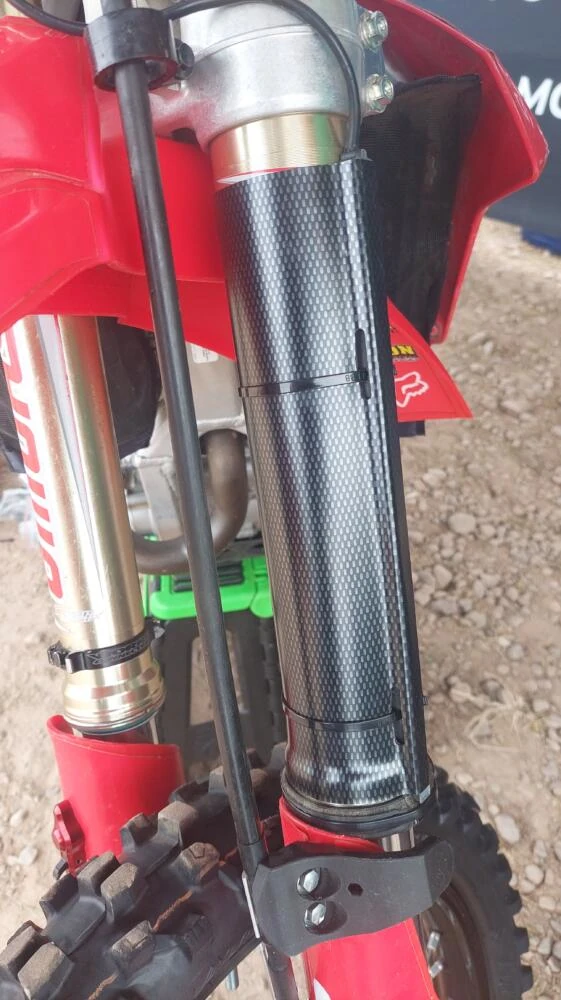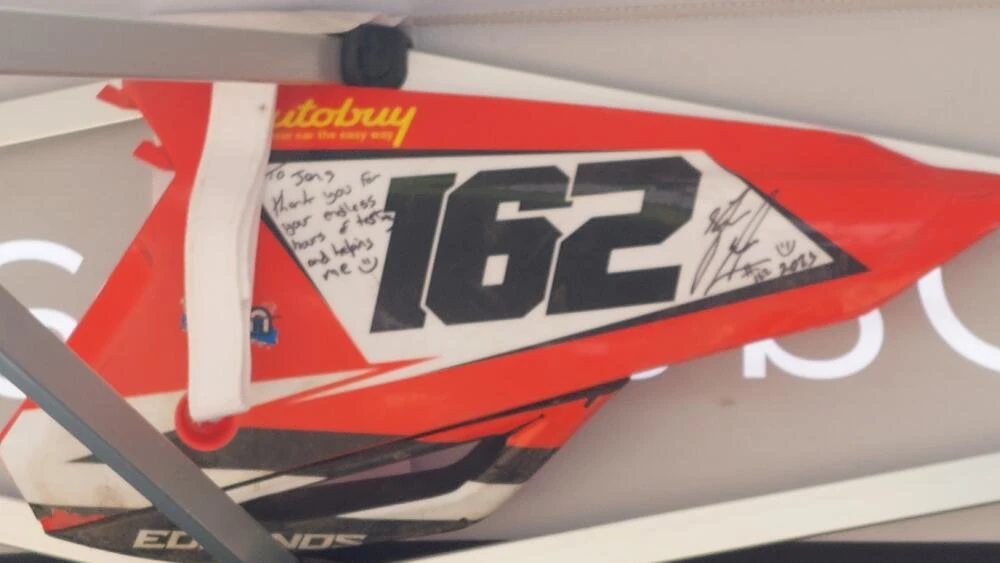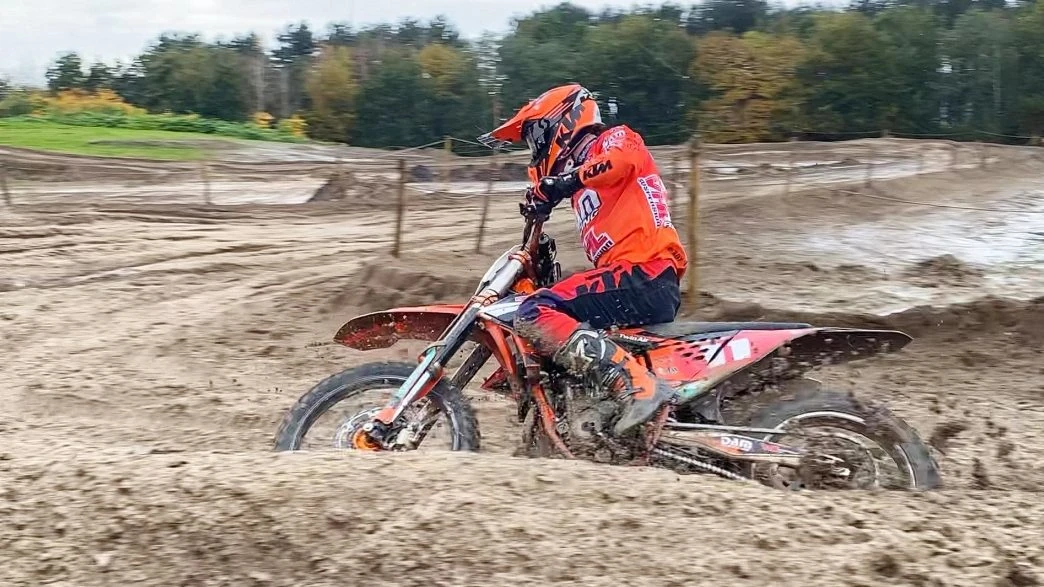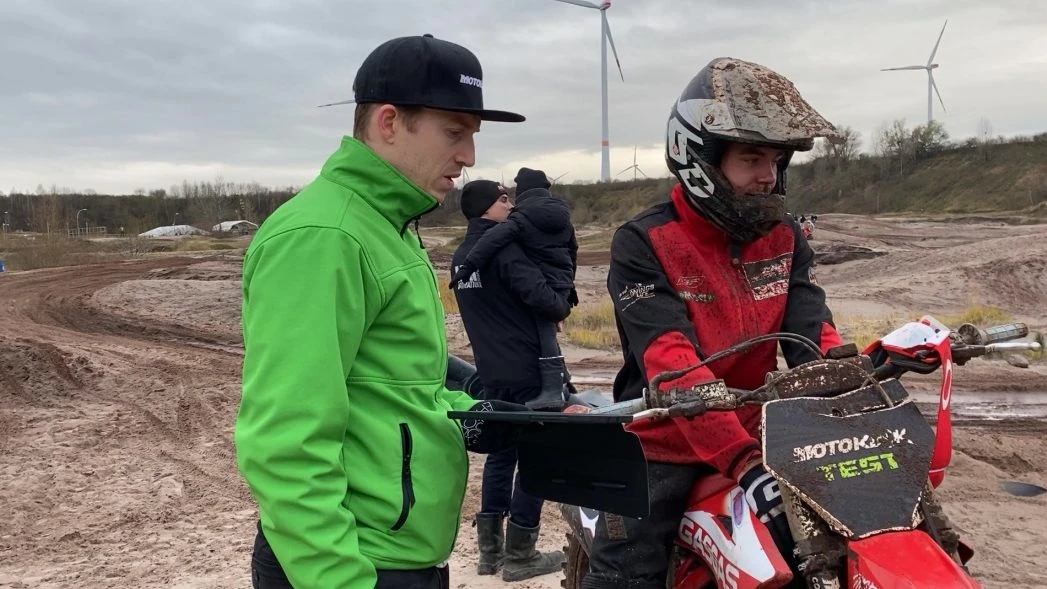
Noppennieuws is the biggest motocross magazine publication in the Netherlands and Belgium, and we were delighted when they agreed to join us for a days testing in Grevenbroich (Germany). The test took place with Boris Blanken of Mellendijk Motor Parts in the Netherlands, and you can read below what the guys had to say about Motoklik. A digital version of the article can be viewed here: Noppennieuws 1 Test_MotoKlik
*The translation is from Google translate, and as such, some of the terms and sentence structures are unconventional in the English language, but it gives good insight into the Motoklik system.
” AS A FANATIC AMATEUR CROSSER AND IT PERSON, THE IRISH JENS KÖPKE HAD FOR SOMETIME THINK ABOUT A DATA RECORDER ON HIS DIRT BIKE, SO THAT HE COULD HAVE VARIOUS DATA FROM HIS MOTORCYCLE AFTER TRAINING READ OUT. AFTER HE HAD A Severe FALL WHEN HIS SUSPENSION PROVED WRONG HAVING BEEN ADJUSTED, HE REALLY GET STARTED WITH IT. IT FINALLY LEAD TO THE CREATION OF THE MOTOKLIK SYSTEM, A DATA RECORDER WITH WHICH IN ADDITION TO LAP TIMES AND RUN LINES PARTICULARLY THE SUSPENSION CAN BE TESTED AND IMPROVED.
Don’t be fooled by its German name, because Jens Köpke is born and raised Irishman, whose passion is motocross. Because he himself against the problem of wrong adjusted suspension hit, he came up with a way to test the suspension on the track. The results are then online or via an app on the phone or laptop to view the targeted to improve suspension. In Ireland he knew to convince an innovation support fund of its idea, which means that he has been there full-time for two years now was able to work on. The system has been shortly on the market and the first cross teams and suspension specialists are already using it.
To see how it works, we are on a cold December day in Grevenbroich, where EMX rider Boris Blanken together with GasGas dealer and WP suspension specialist Albert Mellendijk it system test. Mellendijk has now completed the system partly purchased to improve the suspension of its customers to assess and improve.
“Data recording is extremely important in road racing, but in the cross this is still in the children’s shoes”, observes Köpke. “If you know what’s happens while driving with your motorcycle, where on the circuit, for example, blows the suspension or which place there is too much or too little damping, you can adjust and optimize your suspension much more precisely serenity. In the road race they drive for the suspension tests with special telescopic pick-ups at the front and rear fork, but it was immediately clear to me that those in the cross are far too vulnerable. I have so devised other sensors that protect against sand, mud and can take a beating. In addition, they are easy to assemble: you can install this system in put on a motorbike for about ten minutes.”
The front fork sensor is located behind a carbon cover the outer leg, while the protective cap of the lower leg comes with a holder with a magnet. The sensor can be clicked on for the rear suspension on the rear brake pump and the magnet comes there sit on the rear bridge. Both front and rear so only the magnet moves with the wheel when the motor compresses, so the system has no influence on the operation of the suspension. per motor brand, the sensors and magnetic mounts do differ slightly: you buy a Motoklik set so specific for one motorcycle brand, but you can do buy several sensors, so that you can use it can be used on multiple engine brands. The small CCU electronics box comes behind the front plate to sit. The power comes from the battery or is ‘tapped’ from the socket with a suitable plug diagnostic plug under the buddy. further comes a GPS sensor on top of the handlebars, which will later show exactly where you drove and then also clearly shows the lines driven. On this box also has a button with indicator light around to turn the system on or off. “The CCU measures 100 times per second the position of front and rear fork,” says Köpke. “It turned out in practice find the ideal mix between reliable data and good downloadability via Bluetooth and the internet connection on your phone. The system registers every spring movement and also measures immediately the SAG (static collapse; ed.). On the circuit drawing it automatically generates he afterwards also see exactly how far the suspension is a certain point is sprung and where it is, for example, image breaks. A rider also sees the effect of driving other lines via the lap times and the sector times that the system also records. In addition, you can press any spring movement zoom in and from there you recognize what is happening with the damping is on. There are nowadays so many variables, with in addition to the spring preload and rebound also the high-speed and the low-speed compression damping.
That all becomes with data recording much more transparent. Moreover all measured data comes in one large database and from this the system distils a kind of ideal adjustment for each circuit. In the future you can also see this ideal setting on the special app on your phone, tablet or laptop, so that you can quickly see how and where your suspension position deviates from the ideal setting.” Boris Blanken is positive about the Motoklik system. “Previous I already have a week with the system in Lommel drove and then I immediately got some useful suspension tips from Jens,” he says. “I then turned out with my set screws at the end of the range too so we have at Mellendijk Motor Parts adjusted the setting slightly and the damper again freshly made. Now the adjustment knobs are beautiful again in the middle of their working area and we want to challenge to get to know the Motoklik system well and immediately dot the i’s with my suspension. The system makes every spring movement very well insightful. After the fine tuning here in Grevenbroich my bike now feels much more stable in the holes. He doesn’t do crazy things on this one anymore tough track, but still nice and light to send in” “I think we will go a lot more in the future hear of this system, which is why we now also get in right away and have one buy,” says Albert Mellendijk. “Teams and more serious riders will soon have their own want to have a system for optimizing of the suspension and assessing driving lines on a job. We will accept it as a recognized WP Authorized Service Center are going to use the suspension of to optimize our customers.”
Köpke: “As far as the latter is concerned, it is an additional There is the advantage that a suspension specialist no longer has to go to the cross track for every test. The rider goes for an afternoon ride with the system on his motorcycle and the suspension specialist can from his watch the company live online and, if necessary, provide advice about the setting of the adjustment knobs.
Or the data is subsequently read out in order to meet the adjust the setting accordingly. In the second training session, the rider can then feel the peel, but you can also see that difference in the graphs. This is how we now have Boris’ suspension can also improve. For the rider himself there is also a useful Performance Dashboard in the system. This allows him to view his phone at a glance. storage see how many hours the engine has run, what was the average speed of a driving session and how much difference there is between the various sessions sit. There is also a unique Track-Roughness-Score in the Motoklik system, which takes into account the weight of the job. As a result, you can times of different sessions on a circuit right compare with each other, because the system sees through the suspension how tough the track was at that session and translates that into a sort of corrected lap time. So you can do the first session on a compare flat track to your last session with deep cuts and spurs.” The Motoklik system costs with sensors for one motorcycle brand added €975 excluding VAT. For use on other brands you can put the sensors there then buy separately. There are also additional online applications ties for sale, with which you as a suspension specialist can delve deeper into the subject. More information tie can be found at www.motoklik.com.
Picture 1: Jens Köpke assembles the Motoklik system on the GasGas of Boris Blanken.
Picture 2: The system becomes in a neat box with a manual supplied.
Picture 3: The rear fork sensor is stuck on the brake pump.
Picture 4: The front fork sensor is behind a carbon cap around the fork leg. Under Jens’ left hand see you just got the support with magnet.
Picture 5: On the handlebars comes the GPS sensor with controls button and control LED.
Picture 6: Albert Mellendijk (left) and Boris Blanken receive an explanation of the system.
Picture 7: Motoklik draws the circuit on, records the lap and sector times and let the see spring movement. Through zoom in on one point becomes the damping characteristic teristically visible.
Picture 8: Boris Blanken in action in Grevenbroich for the suspension test.”





























